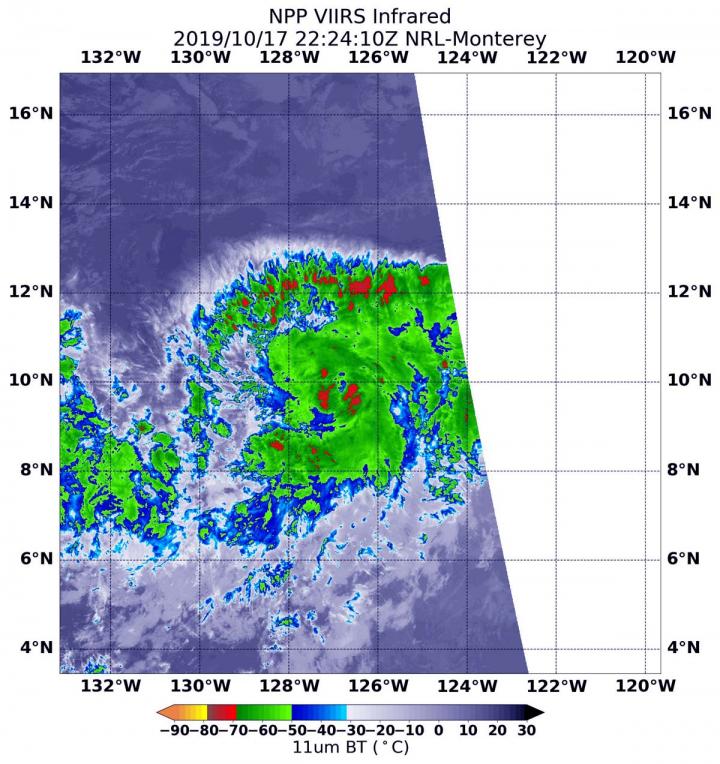
Credit: Credit: NASA/NRL
NASA-NOAA’s Suomi NPP satellite provided infrared data that showed the development of Tropical Storm Octave in the Eastern Pacific Ocean.
Octave formed on Oct. 17 by 5 p.m. EDT as a tropical depression. At that time, it was located about 1,410 miles (2,265 km) southwest of the southern tip of Baja California, Mexico.
The Visible Infrared Imaging Radiometer Suite (VIIRS) instrument aboard Suomi NPP provided an infrared image of the storm. The National Hurricane Center noted that, “The much improved cloud pattern consists of prominent convective curved bands in the east semicircle and recent bursts of deep convection.” Infrared imagery analyzes cloud top temperatures, and the higher the cloud top, the colder it is, and the stronger the storm. On Oct. 17 at 6:24 p.m. EDT (2224 UTC), a VIIRS image found several areas around the center of circulation where cloud top temperatures were as cold as minus 70 degrees Fahrenheit (minus 56.6 Celsius). Storms with cloud tops that cold have been found to generate heavy rainfall.
On Oct. 18, infrared data showed that cloud top temperatures had warmed, meaning they dropped in height. That drop in height indicates a weakening of the uplift of air and a weakening of the storm. NOAA’s National Hurricane Center or NHC said that at 5:41 a.m. EDT (0941 UTC), “Cloud tops have warmed during the past few hours, but the initial intensity is being held at 40 knots based on ASCAT [instrument] data from overnight.”
The Oct. 18 image indicated that wind shear was affecting the storm and pushing the bulk of clouds and precipitation west of the center. NHC noted “The GCOM [Japanese satellite] microwave overpass was instrumental in showing that Octave’s center is located to the east of the main convective mass, and also well to the east of a more notable mid-level circulation.” When the bulk of precipitation and clouds are pushed away from the center, the storm weakens.
At 11 a.m. EDT (1500 UTC) on Oct. 18, the center of Tropical Storm Octave was located near latitude 10.6 degrees north and longitude 126.6 degrees west. That puts the center about 1,390 miles (2,240 km) southwest of the southern tip of Baja California. Octave is now moving toward the north near 2 mph (4 kph), but the storm is expected to meander or make a slow clockwise loop during the next few days. Maximum sustained winds are near 45 mph (75 kph) with higher gusts. The estimated minimum central pressure is 1005 millibars.
Another issue affecting Octave is its movement out of the Intertropical Convergence Zone (ITCZ). NOAA defines the ITCZ as the region where the northeasterly and southeasterly trade winds converge, forming an often continuous band of clouds or thunderstorms near the equator.
As Octave moves out of the ITCZ, low-level dry air to the west is wrapping into the cyclone’s circulation, which is likely causing the recent waning of convection. Therefore, weakening is forecast during the next couple of days, and Octave is expected to degenerate into a remnant low over the weekend.
Hurricanes are the most powerful weather event on Earth. NASA’s expertise in space and scientific exploration contributes to essential services provided to the American people by other federal agencies, such as hurricane weather forecasting.
For updated forecasts. Visit: http://www.
###
Media Contact
Lynn Jenner
[email protected]
Original Source
https:/




